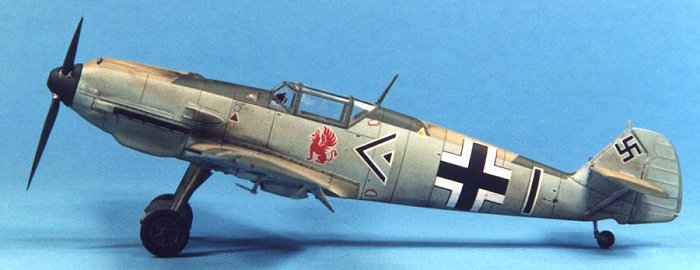
|
KIT: |
Tamiya 1/48 Bf-109E-3* |
|
KIT # |
61050 |
|
PRICE: |
$26.98 |
|
DECALS: |
Three versions: See review |
|
REVIEW & |
|
|
NOTES: |
|

|
HISTORY |
The 60th anniversary of the Battle of Britain (BoB) is upon us, and it is an appropriate time to remember those brave warriors in the air who paid the ultimate sacrifice for their countries. This will be the first installment (the second will be next week) that discusses this important aerial battle and pays tribute to two of the most famous aircraft featured in the BoB, the Messerschmitt BF109, and the Supermarine Spitfire.
On June 18 1940, aware of Hitler’s plan for the invasion of Britain, Winston Churchill made his "Finest Hour" speech calling to arms his fellow countrymen: "The Battle of France is over, the Battle of Britain is about to begin, upon this battle depends the survival of Christian civilization, upon it depends our own British life and the long continuity of our institution and our empire".
Historians often argue as to the exact dates that the BoB was fought, however it is generally agreed that July 10 through 31 October 1940 are the most appropriate dates. The BoB was significant in many ways, not the least of which, is that it was the first major battle to be fought entirely in the air.
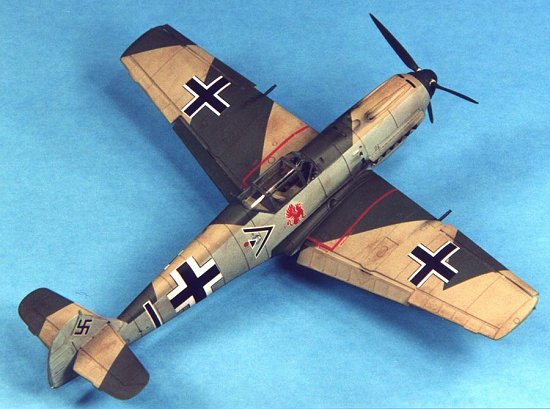 The BoB
consisted of four major phases in support of "Operation Sealion", the
proposed German invasion of the British mainland. Phase 1 which ran from July
through early August was characterized by German attacks on the convoys
supplying Britain in the English Channel and Thames Estuary, attacks on
industrial targets, and large scale German fighter sweeps hoping to draw up the
RAF for destruction. Phase 2 featured "Adlerangriffe", the Luftwaffe’s
planned destruction of the RAF on the ground and in the air, culminating in
"Adlertag" on August 13, one of the largest aerial battles ever
fought. Phase 3 featured a change in German strategy from destruction of RAF
targets, to the "Blitzkrieg" of London in early September, a change in
strategy that many historians argue cost the Germans victory in the BoB. And
lastly, Phase 4 starting in early October, the end of large-scale day attacks
with the majority of the fighting taking place at night over large British
industrial centers and cities.
The BoB
consisted of four major phases in support of "Operation Sealion", the
proposed German invasion of the British mainland. Phase 1 which ran from July
through early August was characterized by German attacks on the convoys
supplying Britain in the English Channel and Thames Estuary, attacks on
industrial targets, and large scale German fighter sweeps hoping to draw up the
RAF for destruction. Phase 2 featured "Adlerangriffe", the Luftwaffe’s
planned destruction of the RAF on the ground and in the air, culminating in
"Adlertag" on August 13, one of the largest aerial battles ever
fought. Phase 3 featured a change in German strategy from destruction of RAF
targets, to the "Blitzkrieg" of London in early September, a change in
strategy that many historians argue cost the Germans victory in the BoB. And
lastly, Phase 4 starting in early October, the end of large-scale day attacks
with the majority of the fighting taking place at night over large British
industrial centers and cities.
PHASE 1 Convoy Attacks & Fighter Sweeps
While 10 July 1940 is generally accepted by most as the start of the BoB, there were many previous attacks by the Luftwaffe on the British mainland. The Luftwaffe made its first large scale attack on the night of 18 June, when a force of over 100 bombers attacked a variety of targets between Yorkshire and Kent. A soon to be famous South African named A.G. "Sailor" Malan shot down two German bombers from his Spitfire that night when they were illuminated by searchlights, an amazing feat of marksmanship. The following night, approximately 100 German bombers hit a variety of targets scattered throughout England and Wales.
The Luftwaffe made its first daylight raid on 1 July, hitting targets in Scotland. This was followed by small-scale daylight raids over the next three days, and combined day/night raids through 9 July. Then on 10 July, the battle started in earnest.
On the morning of 10 July, a ship convoy code-named "Bread" was transiting from the Thames Estuary to the Straits of Dover when it was detected by a reconnaissance DO-17P of 4(F)121. This aircraft was heavily escorted by BF109’s from I./JG51, and six Spitfires from No. 74 intercepted. The Spits were heavily outnumbered by the 20+ BF109’s but managed to attack and damage the DO17, which eventually crash-landed in France. The DO17 managed to alert the Luftwaffe and they responded with over 70 aircraft to attack "Bread" later in the afternoon. About 30 British fighters intercepted the German formation and the first large-scale dogfight of the BoB ensued. A total of 6 RAF and 13 German aircraft were lost in this engagement, but the most significant fact of the battle was that only one ship from "Bread" was lost. In addition, coincident with the raid on "Bread", a strike force of JU88’s hit Swansea and Falmouth. The British did not intercept this attack. Further shipping attacks were accomplished on 11-18 July, although generally poor weather hampered operations.
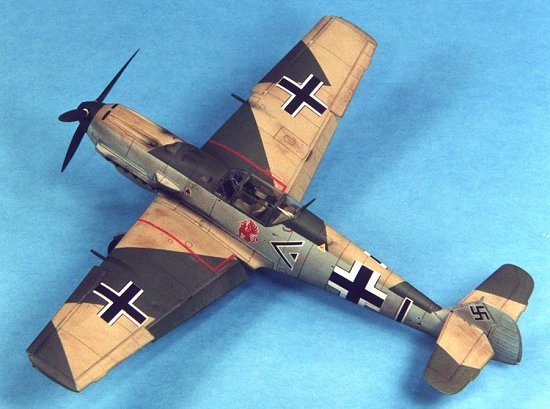 On 19
July weather improved and the B.P. Defiants from 141 Squadron were patrolling in
the English Channel. The Defiants were jumped by over 20 BF109’s from
III./JG51 and in the ensuing battle six Defiants were lost while JG51 lost only
one BF109. The carnage may have been worse had not 111 Squadron arrived on the
scene to ward off the BF109’s. This battle illustrated the weakness of the
Defiant against the far superior BF109 and along with another disastrous
engagement in August led to the withdrawal of the Defiant from day operations.
On 19
July weather improved and the B.P. Defiants from 141 Squadron were patrolling in
the English Channel. The Defiants were jumped by over 20 BF109’s from
III./JG51 and in the ensuing battle six Defiants were lost while JG51 lost only
one BF109. The carnage may have been worse had not 111 Squadron arrived on the
scene to ward off the BF109’s. This battle illustrated the weakness of the
Defiant against the far superior BF109 and along with another disastrous
engagement in August led to the withdrawal of the Defiant from day operations.
Further small scale convoy attacks and fighter sweeps continued throughout the month, and the Luftwaffe aces suffered some heavy losses when Noacke, von Houwald, Erlich, Riegel, and Keidel were lost and leading German ace Werner Moelders was shot down and wounded.
A combination of poor weather, and German preparations for "Adlertag", the all out assault of the RAF in the air and on the ground led to lower levels of combat activity through the early days of August. On 2 August, Goering issued the final orders for "Adlertag" which was to commence on 10 August. The last major German attack before "Adlertag", which was to be forewarning of the immense aerial battles yet to come, occurred on 8 August when convoy "Peewit" was attacked in an immense aerial battle by over 150 German aircraft. These were opposed by approximately 30 RAF fighters in an intense dogfight. Casualties were high on both sides, the RAF losing 19 aircraft and the Luftwaffe losing 31 aircraft, along with a significant amount of shipping lost.
|
THE KIT |
Scott has recently completed an excellent review of this kit . I agree completely with everything he has written and can add nothing of any significance to his review except to expand the history section. I will say I did not experience any of the problems he noted in that the wings were completely free of any sink marks, I had no dihedral problems, and I did not use a spot of putty any where on the model.
|
PAINT & DECALS |
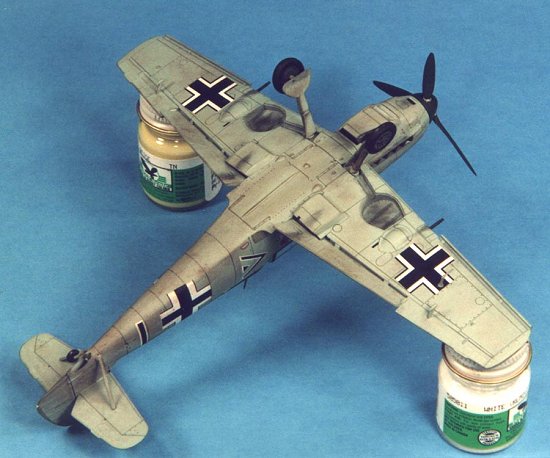 I chose
to model the aircraft flown by German ace Adolf Galland that he flew with JG26
early in the BoB. The aircraft is in the standard early Luftwaffe splinter
scheme of RLM 65/71/02. I used Polly Scale acrylic paint throughout. After
letting the paint dry overnight, I airbrushed a light coat of Future to prepare
the surface for decaling. The decals went on quite well and responded to
Microsol without any permanent wrinkling. After drying overnight, I wiped the
decals off with a moist cloth with Pollys Plastic Prep to remove any residue and
after drying I shot a light coat of Future over the decals to seal them.
I chose
to model the aircraft flown by German ace Adolf Galland that he flew with JG26
early in the BoB. The aircraft is in the standard early Luftwaffe splinter
scheme of RLM 65/71/02. I used Polly Scale acrylic paint throughout. After
letting the paint dry overnight, I airbrushed a light coat of Future to prepare
the surface for decaling. The decals went on quite well and responded to
Microsol without any permanent wrinkling. After drying overnight, I wiped the
decals off with a moist cloth with Pollys Plastic Prep to remove any residue and
after drying I shot a light coat of Future over the decals to seal them.
Next, a light coat of Polly S Flat Finish was shot to provide a surface for pastels. I used an engineering pencil sharpened to a fine point to highlight the panel lines. This gives a more subtle effect than my usual wash technique that I really liked, but it was a little more time consuming. I then used pastels applied with a soft brush to simulate the dirt staining that is commonly seen on these aircraft which were operated from grass fields. Lastly, I sealed everything with a light coat of Polly S Flat Finish.
|
CONCLUSIONS |
Tamiya models are my absolute favorite to build, as they usually have no major problems to contend with. This kit was no exception, and not a single spot of filler was needed. This kit makes a beginner modeler look like an expert and is highly recommended.
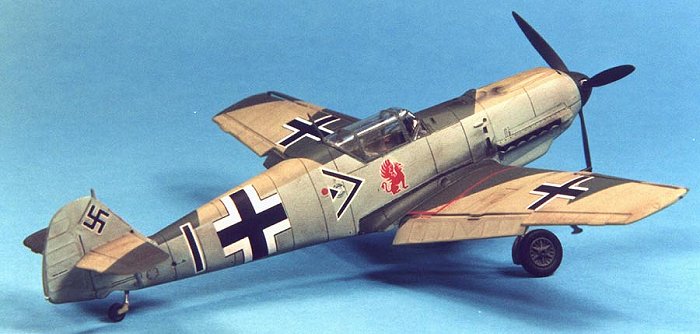
|
REFERENCES |
Squadron/Signal Publications, Messerschmitt BF109 in Action #44
Smithmark Publishers, The Battle of Britain
If you would like your product reviewed fairly and quickly by a site that has over 1400 visits a day, please contact me or see other details in the Note to Contributors.